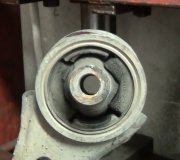I've always stuck with original size tires while working at a Chrysler dealership. As the owner of many Dodge muscle cars from the '70s, I know what looks better than the original sizes, but when it comes to handling, those cars were pretty primitive in their engineering compared to newer stuff, so you couldn't really degrade their handling too much.
As an instructor I spend a lot more time on correct ride height. Altering that has an even bigger affect than changing tire sizes and is the type of modifications lawyers and insurance investigators love to find. I can't stop my kids from from making those changes to their cars and trucks, but they won't do it in my shop.
The "235" in your tire sizes refers to 235 millimeters across the tread, so that is the same for both tires. The "75" means the sidewalls are 75 percent the size of the tread, or in this case, 176.25 millimeters. Since the 16" tire is 1" larger in center diameter, and the sidewalls are the same, the outer diameter also has to be 1" larger. That's pretty significant. The circumference will be over 3" larger. That will make your speedometer read lower than your actual speed. I can't say for sure, but I would suspect that even if the tires don't rub on the fenders, they are likely to rub on the strut rods that go from the lower control arms to the frame brackets under the seats.
Sunday, January 27th, 2013 AT 6:02 AM



